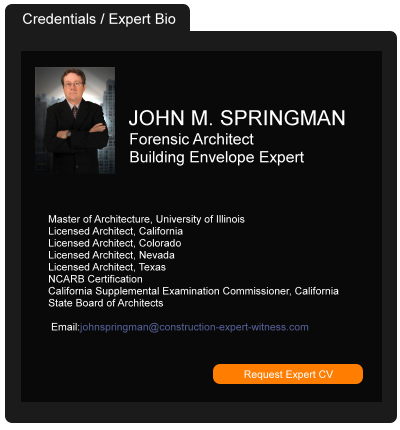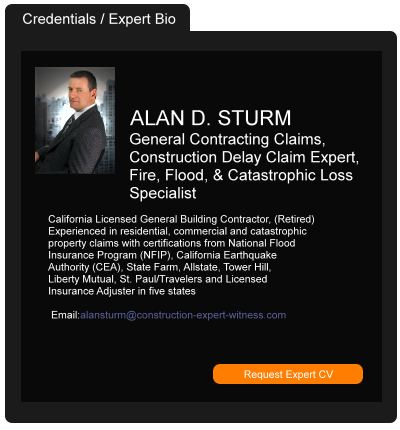Another Reminder that Your Construction Contract Language Matters
June 06, 2018 —
Christopher G. Hill - Construction Law MusingsHere at Musings, I have often (some might say too often) discussed the fact that in Virginia (as well as other places), your construction contract language will be strictly enforced. I have also discussed the need for attorney fees provisions as well as other language in order to mitigate your risk as a contractor. A recent case from the City of Roanoke Circuit Court discussed both of these principals and their intersection.
In LAM Enterprises, LLC v. Roofing Solutions, Inc., the Roanoke Court looked at a contract between LAM and Roofing Solutions, Inc. that contained two provisions of the construction contract between the parties. The first provision limited the liability of Roofing Solutions to the contract price. The second provision is a relatively typical “prevailing party” attorney fees provision in which the winner of any lawsuit would be entitled to collect its attorney fees. For the specific language of these provisions, I commend the opinion linked above for your reading.
Read the court decisionRead the full story...Reprinted courtesy of
Christopher G. Hill, The Law Office of Christopher G. HillMr. Hill may be contacted at
chrisghill@constructionlawva.com
California Imposes New Disabled Access Obligations on Commercial Property Owners
October 07, 2016 —
Garret Murai – California Construction Law BlogThe following article was written by my colleague
David Goldman on the new ADA accessibility legislation which was signed into law this past month by Governor Brown.
Since July 1, 2013, California Civil Code section 1938 has required commercial property owners to disclose in every commercial lease whether the property being leased has been inspected by a Certified Access Specialist (“CASp”). A CASp is an individual certified by the State of California as qualified and knowledgeable of construction-related access to public accommodations by persons with disabilities. In addition to disclosing whether or not the property being leased has been CASp inspected, if a CASp inspection has occurred, the commercial lessor must disclose in the lease whether the premises has or has not met all the applicable construction-related accessibility standards established by law. These lease requirements, along with other disability access obligations, were discussed in an
earlier article written in 2012.
Read the court decisionRead the full story...Reprinted courtesy of
Garret Murai, Wendel, Rosen, Black & Dean LLPMr. Murai may be contacted at
gmurai@wendel.com
Is There Direct Physical Loss Under A Property Policy When COVID-19 is Present?
April 06, 2020 —
Tred R. Eyerly - Insurance Law HawaiiMost property policies provide coverage for property damage only when there is "direct physical loss" to covered property. Early indications are that COVID-19 remains on surfaces. The duration can last from a few hours to three weeks, depending on the type of surface material. If an employee is infected and the store or restaurant must closed because the virus may rest on surfaces within the building, is there direct physical loss, even though the building structure itself is unharmed?
To answer this question, cases from jurisdictions outside Hawaii may provide guidance. In a case from Louisiana, the homeowner had to move out of her home when excessive levels of organic lead were discovered in the kitchen, living room, master bedroom, and attic. Widder v. La. Citizens Prop. Ins. Corp., 82 So. 3d 294 (La. Ct. App. 2011). The insurer denied coverage because there was no direct physical loss. The trial court agreed; since the home was still intact, no direct physical loss had occurred, so there was no coverage under the policy. The appellate court reversed. It compared the presence of inorganic lead in the home to cases that found a direct physical loss from the existence of Chinese drywall, from which gaseous fumes were released, rendering the home unusable or uninhabitable. Physical damage was not necessary.
What if smoke from a nearby wildfire fills an outdoor theater, forcing cancellation of performances and loss of business income? This was the situation in Oregon Shakespeare Festival Ass'n v. Great Am. Inc. Co., 2016 U.S. DIst. LEXIS 74450 (D. Ore. Jun 7, 2016). Wildfires in the area caused smoke, soot, and ash to accumulate on the surface of seats and concrete ground of the open-air theater. The air quality was poor, but no federal, state or local agency ordered cancellation of the performances. Further, the theater did not suffer any permanent or structural damage to its property. The insurer denied coverage, contending that the loss or damage must be structural to the building itself. After all, the smoke in the air at the theater did not require any repairs to the structure of the property. The court disagreed. The theater sustained "physical loss or damage to property" when the wildfire smoke infiltrated the theater and rendered it unusable for its intended purpose. The decision in Oregon Shakespeare Festival was eventually vacated by a joint stipulation of the parties. Oregon Shakespeare Festival Ass'n v. Great Am. Ins.Co., 2017 U.S. Dist. LEXIS 33208 (D. Ore. March 6, 2017), but the reasoning is still sound.
Read the court decisionRead the full story...Reprinted courtesy of
Tred R. Eyerly, Damon Key Leong Kupchak HastertMr. Eyerly may be contacted at
te@hawaiilawyer.com
Read Before You Sign: Claim Waivers in Project Documents
July 06, 2020 —
William E. Underwood - ConsensusDocsNot all claim waivers are appropriately titled “Waiver of Claims.” In fact, claim waivers can be found “hiding” without any advertisement or fanfare in a number of project documents, including change orders and applications for payment. So although getting work quickly approved and paid for is important, taking time to read the specific language in your project documents is just as important. Failure to pay close attention to this language could result in the waiver of key, unresolved project claims.
Further, and although it should go without saying, it is also just as important to read all of the terms of your contract. Important waiver language might not exist on the face of form project documents, but rather might be contained in the general and/or supplemental conditions of your contract and automatically incorporated into your form project documents. And these types of incorporated waivers can be just as enforceable.
So it is critically important to understand what you are signing and the implications it might have on future claims. This article will explore some of the common types of claim waivers that can be found in project documents so that you are better positioned to avoid inadvertently waiving claims in the future.
Read the court decisionRead the full story...Reprinted courtesy of
William E. Underwood, Jones Walker LLPMr. Underwood may be contacted at
wunderwood@joneswalker.com
Some Work Cannot be Included in a Miller Act Claim
June 28, 2021 —
Christopher G. Hill - Construction Law MusingsThe Miller Act is close to my heart here at Construction Law Musings. Payment bond claims under the Miller Act help protect subcontractors on construction projects where the national government or its agencies are the owners of the property and therefore mechanic’s liens are unavailable. Even where you follow the proper claims process under this statute, the question remains as to what sorts of costs can be included in the claim.
A recent case out of the Eastern District of Virginia federal court in Alexandria, VA gives some insight into the limits of claims under the federal Miller Act. In Dickson v Forney Enterprises, Inc. et. al., the Court looked at the question of whether costs of a project manager’s purely clerical duties can be included and correspondingly whether performing those duties can extend the relevant one-year limitations period for filing suit.
Read the court decisionRead the full story...Reprinted courtesy of
The Law Office of Christopher G. HillMr. Hill may be contacted at
chrisghill@constructionlawva.com
What You Need to Know About Enforcement Actions by the Contractors State License Board
April 15, 2015 —
Garret Murai – California Construction Law BlogI questioned whether to even write this post.
Because, of course, YOU would never find yourself hightailing it out of town with the California Contractor’s State License Board (“CSLB”) sniffing down your tail pipes.
Then again, mistaken identities occur all the time. So, here’s what you need to know if the CSLB mistakes you for one of “those” contractors.
What violations are subject to CSLB enforcement actions?
The CSLB can take enforcement actions based on any one of numerous violations set forth under the California Business and Professions Code (“B&P Code”), including:
1.
B&P Code §7107: Abandonment of a construction project or operation without legal excuse.
Read the court decisionRead the full story...Reprinted courtesy of
Garret Murai, Wendel Rosen Black & Dean LLPMr. Murai may be contacted at
gmurai@wendel.com
How U.S. Design and Architecture Firms Can Profit from the Chinese Market and Avoid Pitfalls
December 23, 2024 —
Chengdong ("C.D.") Xing - The Dispute ResolverDespite recent challenges, including obvious political tensions, economic cooling in the PRC, and increased local competition, the Chinese market remains an attractive destination for U.S. design and architecture firms. For instance, PEI Architects has maintained its success in China through long-standing relationships with key clients and is currently involved in two major projects for the Bank of China: a 1.9 million-square-foot complex in Shanghai and a financial center in Haikou.[i] Similarly, NBBJ is playing a critical role in the development of Tencent’s Net City in Shenzhen, a 2-million-square-meter smart city project that aligns with China's goals of sustainable and tech-driven urbanization.[ii] These examples show that while the Chinese market presents challenges, it continues to offer significant opportunities, particularly in sectors where innovative and cutting-edge architectural solutions are in high demand. At the same time, U.S. firms should exercise care: proper advance planning and strategic alliances are crucial for profitable forays into the Chinese market.
JR Design Project: A Cautionary Tale
When operating in China, U.S. design firms often encounter regulatory challenges, particularly with respect to China’s strict qualification requirements for architectural design services. Failure to meet these requirements can result in serious legal issues, including the potential invalidation of design contracts, as demonstrated in a leading case decided by the Supreme People’s Court of PRC (the nation’s highest court).
Read the court decisionRead the full story...Reprinted courtesy of
Chengdong ("C.D.") Xing, Rajah & Tann Singapore LLPMr. Xing may be contacted at
chengdong.xing@rajahtann.com
CDJ’s #3 Topic of the Year: Burch v. The Superior Court of Los Angeles County, 223 Cal.App.4th 1411 (2014)
December 31, 2014 —
Beverley BevenFlorez-CDJ STAFFIn 2013, the case Liberty Mutual Insurance Company v. Brookfield Crystal Cove, LLC received a great deal of attention for its possible ramifications to how California’s Right to Repair Act (also known as SB 800) could be applied. However, 2014 had its share of SB 800 policy trends, most notably caused by the ruling in Burch.
In their article, “Construction Law Client Alert: California’s Right to Repair Act (SB 800) Takes Another Hit, Then Fights Back,” authors Steven M. Cvitanovic and Whitney L. Stefco, of Haight Brown & Bonesteel, analyzed Burch as well as KB Home Greater Los Angeles v. The Superior Court of Los Angeles County, et al., both cases that had ramifications on how California’s Right to Repair Act is applied.
Read the full story...
Karen L. Moore of Low, Ball & Lynch discussed the Liberty Mutual and Burch cases in her article, “California’s Right to Repair Act is Not a Homeowner’s Exclusive Remedy when Construction Defects cause Actual Property Damage.”
Read the full story...
Read the court decisionRead the full story...Reprinted courtesy of


































































